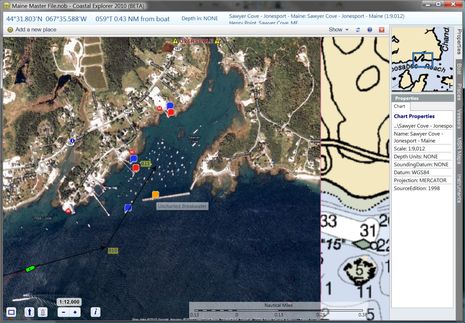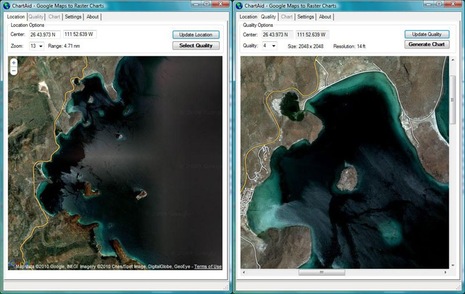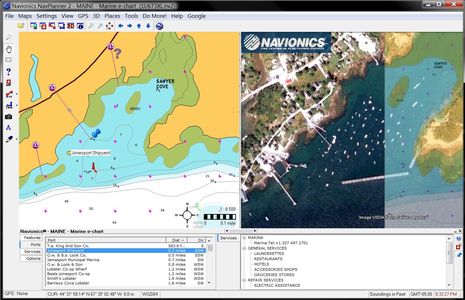Jonesport breakwater aid, with ChartAid

An interesting solution for the Jonesport uncharted breakwater problem came all the way from the S/V True Love in La Paz, Mexico. Skipper Bill Stockton has written a program called ChartAid which can turn Google Earth photo maps into BSB format so you can navigate on them in programs like CE, Nobeltec, and Chart View. I did get an "Invalid BSB" warning when I installed the chart Bill sent into CE, but it works fine. As you can see above, the registration with the official chart looks good, and my vessel, track, and route, plus data sets like GuideBook, overlay properly. Even the "properties" make sense, with the possible exception of the Source date. And apparently it's easy to make such photo 'charts' with ChartAid...
I haven't tried ChartAid, but the instructions and screen shots (below) suggest that there's little effort involved, and a fair bit of control over map boundaries, file size, and quality. It runs on Windows and a thirty day trial is free; after that the license is $99. I certainly wouldn't want to do primary navigation on Google Earth photos in the semi-opaque waters I cruise, or anywhere really, but these 'charts' could be very useful on a second navigation window, especially where the water is clear and/or the available charts are really poor...like Mexico. And ChartAid reminded me that Fugawi has done some interesting work with Google Earth... So I fired up Navionics Planner2, which is a version of Fugawi ENC, and didn't have any trouble installing the Google Earth plug-in. It's pretty slick. Essentially you're running GE full speed in a Fugawi window, and, if you want, it can syncronize with panning and zooming in the chart window. You can also turn chart windows into Google overlays with adjustable transparency, as shown in the screen shot. And according to the plug-in info I linked to you can also "Import
Google Earth maps to Fugawi Panel", which sounds like ChartAid but apparently requires the full Fugawi ENC to work. There are lots of ways to be forewarned about an uncharted breakwater.
So I fired up Navionics Planner2, which is a version of Fugawi ENC, and didn't have any trouble installing the Google Earth plug-in. It's pretty slick. Essentially you're running GE full speed in a Fugawi window, and, if you want, it can syncronize with panning and zooming in the chart window. You can also turn chart windows into Google overlays with adjustable transparency, as shown in the screen shot. And according to the plug-in info I linked to you can also "Import
Google Earth maps to Fugawi Panel", which sounds like ChartAid but apparently requires the full Fugawi ENC to work. There are lots of ways to be forewarned about an uncharted breakwater.

 Share
Share
This is very cool! I have written to Bill Stockton (the author) to ask if his program can use formats other then GE, which would be very handy in lots of ways (other aerial photos, for example).
Michael